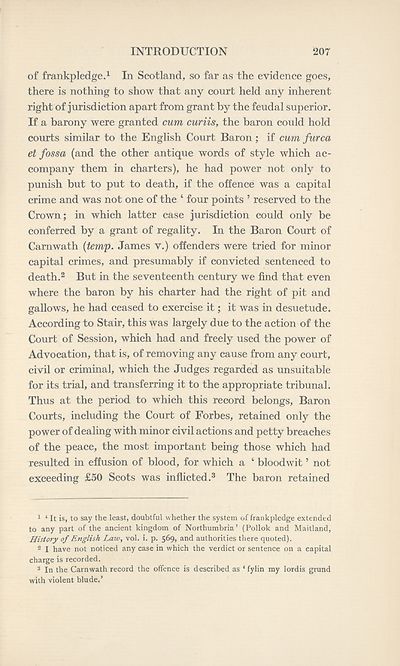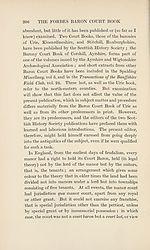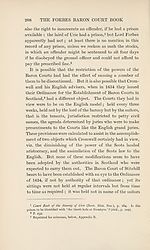Series 2 > Miscellany of the Scottish History Society
(224) Page 207
Download files
Complete book:
Individual page:
Thumbnail gallery: Grid view | List view

INTRODUCTION
207
of frankpledge.1 In Scotland, so far as the evidence goes,
there is nothing to show that any court held any inherent
right of jurisdiction apart from grant by the feudal superior.
If a barony were granted cum curiis, the baron could hold
courts similar to the English Court Baron ; if cum furca
et fossa (and the other antique words of style which ac¬
company them in charters), he had power not only to
punish but to put to death, if the offence was a capital
crime and was not one of the ‘ four points ’ reserved to the
Crown; in which latter case jurisdiction could only be
conferred by a grant of regality. In the Baron Court of
Carnwath (temp. James v.) offenders were tried for minor
capital crimes, and presumably if convicted sentenced to
death.2 But in the seventeenth century we find that even
where the baron by his charter had the right of pit and
gallows, he had ceased to exercise it; it was in desuetude.
According to Stair, this was largely due to the action of the
Court of Session, which had and freely used the power of
Advocation, that is, of removing any cause from any court,
civil or criminal, which the Judges regarded as unsuitable
for its trial, and transferring it to the appropriate tribunal.
Thus at the period to which this record belongs, Baron
Courts, including the Court of Forbes, retained only the
power of dealing with minor civil actions and petty breaches
of the peace, the most important being those which had
resulted in effusion of blood, for which a ‘ bloodwit ’ not
exceeding £50 Scots was inflicted.3 The baron retained
1 ‘ It is, to say the least, doubtful whether the system of frankpledge extended
to any part of the ancient kingdom of Northumbria’ (Pollok and Maitland,
History of English Law, vol. i. p. 569, and authorities there quoted).
2 I have not noticed any case in which the verdict or sentence on a capital
charge is recorded.
3 In the Carnwath record the offence is described as ‘ fylin my lordis grand
with violent blude.’
207
of frankpledge.1 In Scotland, so far as the evidence goes,
there is nothing to show that any court held any inherent
right of jurisdiction apart from grant by the feudal superior.
If a barony were granted cum curiis, the baron could hold
courts similar to the English Court Baron ; if cum furca
et fossa (and the other antique words of style which ac¬
company them in charters), he had power not only to
punish but to put to death, if the offence was a capital
crime and was not one of the ‘ four points ’ reserved to the
Crown; in which latter case jurisdiction could only be
conferred by a grant of regality. In the Baron Court of
Carnwath (temp. James v.) offenders were tried for minor
capital crimes, and presumably if convicted sentenced to
death.2 But in the seventeenth century we find that even
where the baron by his charter had the right of pit and
gallows, he had ceased to exercise it; it was in desuetude.
According to Stair, this was largely due to the action of the
Court of Session, which had and freely used the power of
Advocation, that is, of removing any cause from any court,
civil or criminal, which the Judges regarded as unsuitable
for its trial, and transferring it to the appropriate tribunal.
Thus at the period to which this record belongs, Baron
Courts, including the Court of Forbes, retained only the
power of dealing with minor civil actions and petty breaches
of the peace, the most important being those which had
resulted in effusion of blood, for which a ‘ bloodwit ’ not
exceeding £50 Scots was inflicted.3 The baron retained
1 ‘ It is, to say the least, doubtful whether the system of frankpledge extended
to any part of the ancient kingdom of Northumbria’ (Pollok and Maitland,
History of English Law, vol. i. p. 569, and authorities there quoted).
2 I have not noticed any case in which the verdict or sentence on a capital
charge is recorded.
3 In the Carnwath record the offence is described as ‘ fylin my lordis grand
with violent blude.’
Set display mode to:
![]() Universal Viewer |
Universal Viewer | ![]() Mirador |
Large image | Transcription
Mirador |
Large image | Transcription
Images and transcriptions on this page, including medium image downloads, may be used under the Creative Commons Attribution 4.0 International Licence unless otherwise stated. ![]()
| Scottish History Society volumes > Series 2 > Miscellany of the Scottish History Society > (224) Page 207 |
|---|
| Permanent URL | https://digital.nls.uk/127194093 |
|---|
| Attribution and copyright: |
|
|---|
| Description | Over 180 volumes, published by the Scottish History Society, containing original sources on Scotland's history and people. With a wide range of subjects, the books collectively cover all periods from the 12th to 20th centuries, and reflect changing trends in Scottish history. Sources are accompanied by scholarly interpretation, references and bibliographies. Volumes are usually published annually, and more digitised volumes will be added as they become available. |
|---|


